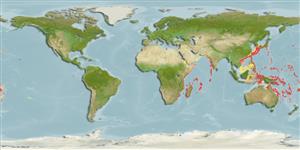>
Beryciformes (Sawbellies) >
Berycidae (Alfonsinos)
Etymology: Beryx: Greek, beryx or berys = a name of a fish. Cuvier & Valenciennes (1829:221) precise that the name was used by Gesner from Varinus, but with no indication whatsoever helping identifying any species. After D'Arcy Wentworth Thompson (A glossary of Greek fishes, 1947), the name actually seems to come originally from Hesychius, but perhaps the name was not originally a fish name. Thompson compares it to meryx (ruminant), applied on skaros (Scarus), so it may have been applied on a parrot fish referring to its browsing/grazing behavior described by Aristoteles and followers.
Environment: milieu / climate zone / depth range / distribution range
Ecologia
marinhas bentopelágico; intervalo de profundidade 100 - 500 m (Ref. 42565). Deep-water
Northwest Pacific: Japan. Also known from the Western Indian Ocean.
Tamanho / Peso / Idade
Maturity: Lm ? range ? - ? cm
Max length : 30.0 cm SL macho/indeterminado; (Ref. 42565)
Descrição breve
Chaves de identificação | Morfologia | Morfometria
Espinhos dorsais (total) : 4; Raios dorsais moles (total) : 12 - 13; Espinhos anais: 4; Raios anais moles: 27 - 32.
Life cycle and mating behavior
Maturidade | Reprodução | Desova | Ovos | Fecundidade | Larvas
Hayashi, M., 2002. Berycidae. p. 485-486. In T. Nakabo (ed.). Fishes of Japan with pictorial keys to the species (second edition). Tokai University Press, 1749 p. (Ref. 42565)
Categoria na Lista Vermelha da IUCN (Ref. 130435: Version 2024-1)
Ameaça para o homem
Harmless
Utilização humana
Ferramentas
Relatórios especiais
Descarregue XML
Fontes da internet
Estimates based on models
Preferred temperature (Ref.
123201): 12.6 - 21.3, mean 16.2 °C (based on 189 cells).
Phylogenetic diversity index (Ref.
82804): PD
50 = 0.6260 [Uniqueness, from 0.5 = low to 2.0 = high].
Bayesian length-weight: a=0.01122 (0.00514 - 0.02450), b=3.04 (2.87 - 3.21), in cm total length, based on all LWR estimates for this body shape (Ref.
93245).
Nível Trófico (Ref.
69278): 3.9 ±0.5 se; based on size and trophs of closest relatives
Resiliência (Ref.
120179): Baixo, tempo mínimo de duplicação da população 4,5 - 14 anos (Preliminary K or Fecundity.).
Fishing Vulnerability (Ref.
59153): Low to moderate vulnerability (27 of 100).
